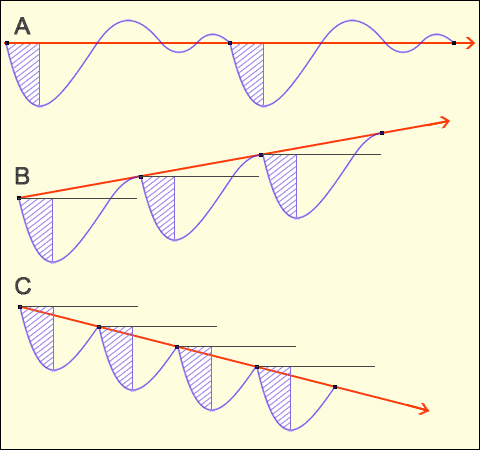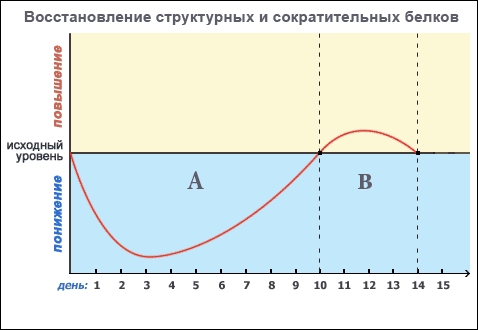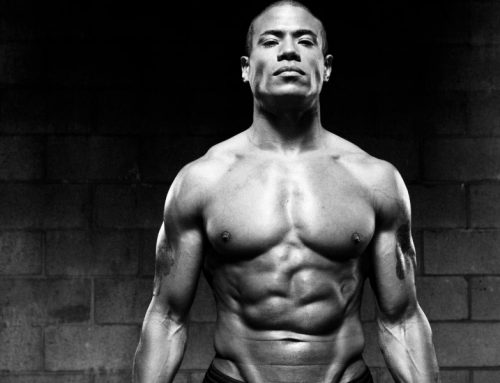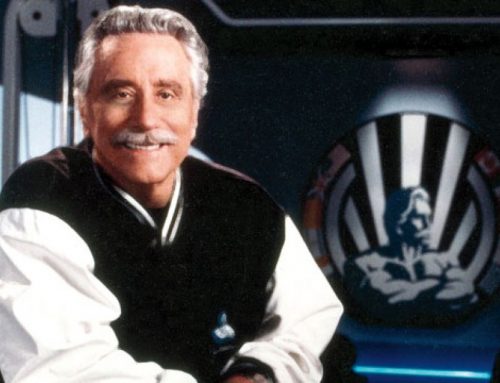At present, the following basic regularities of the development of adaptation (adjustment) to the effects of physical loads in the process of training have been established:
- principle of overexertion,
- the principle of specificity,
- principle of reversibility of action,
- principle of positive interaction,
- the principle of sequential adaptation,
- the principle of cyclicality.
The principle of overtraining (or the principle of progressive muscle overload) is that muscles need ever-increasing loads to grow continuously. If you keep training with the same weight and the same number of repetitions, your muscles will eventually adapt to the load and stop responding to it. Therefore, it is necessary to periodically increase the training load. The greater the load – the greater the muscle growth. However, this principle is true to a certain extent. If the load is excessive, the so-called “adaptation failure” can be observed, when the opposite effect is observed – increasing the load leads to a decrease in the rate of muscle growth or leads to overloading the body and reducing muscle mass. In other words, the load must be sufficient to stimulate the muscles to grow. If muscle growth is observed at a lower load, there is absolutely no need to increase the load.
The principle of specificity is that adaptive changes in the body occur to a greater extent in those systems that are maximally activated by a specific type of physical activity. Generalizing as much as possible, the effect of the principle of specificity can be expressed as follows: if you want to run fast – you must run; if you want to swim fast – you must swim; if you want to bench press 200 kg, you do not need to run 40 kilometers in training – you must perform strength training in the bench press. In other words, to get a certain result, you have to do exactly the right kind of training work. You cannot apply completely different training loads and get the same result in all cases.
In a narrower sense, as applied to bodybuilding, the principle of specificity can mean the following: if you want to develop the upper pectoral muscles, for example, you must choose the exercises that engage the upper pectoral muscles to a greater extent.
And if to specify the principle of specificity in relation to bodybuilding to the maximum extent possible, it can be reduced to the following: if you want to increase muscle mass to the maximum extent possible, you should use such a training load, which to the maximum extent causes the destruction of structural and contractile proteins in order to cause the subsequent maximum supercompensation.
It follows from the principle of reversibility of action that exercise-induced adaptive changes in the body are transient. After you stop loading your muscles, their volume will gradually decrease until, after a certain period of time, they return to their original level. As we already know, after a strenuous training, which leads to a significant destruction of protein structures, they recover not to the initial level, but with an excess of the initial level (the phenomenon of supercompensation or super-recovery). However, after the super-recovery phase is over, these indices return to normal. To avoid starting each workout at the same level as the previous workout, repeated loads should be set during the super-recovery phase. The interaction of the various training effects is illustrated in the following figure:

Summarization of training effects when loads are repeated at different rest intervals:
- A – in the hardened state phase – neutral interaction;
- B – in the super-recovery phase – positive interaction;
- C – in the phase of recovery – negative interaction;
- C – in the recovery phase – negative interaction;
As you can see, if you make too long rest intervals between repeated training of muscle groups, that is, to conduct subsequent training in the phase of consolidated state, you will not be able to summarize the positive effects of the phenomenon of supercompensation. Muscle changes will return to the initial level, and you will have muscle pains from the same load all the time, because each training session will be perceived by the body as a new one, but in this case muscle mass will not increase.
If you make too short intervals between repeated workouts of a muscle group, you will cause dystrophic changes in the muscle because you will not give the muscle a chance to recover. As you already know, training load leads to the breakdown of the proteins and structural elements of the muscle. So how can you hope to increase muscle mass by constantly destroying it? To increase muscle mass, you must give the muscle a chance to recover from the load and then, when the over-recovery phase occurs, train again.
Re-loading should only be set during the super-recovery phase. And at this point the following question may arise: “And when does the super-recovery phase occur?”. Let’s try to answer it. We know that repetitive training with the same load, done after 14 days, causes muscle soreness. This signals that the muscle has returned to its original state and the super-recovery phase is complete. Full restoration of normal muscle ultrastructure occurs within about 10 days. This means that the recovery phase is complete by about day 10. Based on these data, we can try to construct a graph of muscle recovery after maximal intensity loading. It will look something like this:

Duration of the recovery and super-recovery phases of muscle ultrastructure.
- A – recovery phase,
- B – the super-recovery phase.
The following point should be noted here – the graph above represents the rate of recovery of structural and contractile proteins after maximal intensity exercise in an athlete not using powerful recovery drugs.
Using a lower intensity load such as 50%, 60%,70% or 80% of maximal intensity will result in a corresponding decrease in the recovery period of the protein structures, as the protein structures will break down to a lesser extent with a lower intensity load.
It should also be noted that the use of anabolic steroids, depending on the dosage, accelerates anabolic processes in the body to varying degrees and, in particular, shortens the recovery period of destroyed protein structures.
There are two other categories of athletes who can recover faster than this period and, accordingly, must train a particular muscle group more frequently in a weekly cycle:
- Beginners, as they do not have a sufficient degree of training to cause severe damage to muscle structures.
- People with weak nervous systems, because they cannot generate high frequency nerve impulses long enough to perform an approach with the necessary intensity and duration to cause significant damage to muscle structures.
- An individual with a weak nervous system, because they cannot generate high frequency nerve impulses long enough to perform an approach with the necessary intensity and duration to cause significant damage to muscle structures.
The principle of positive interaction is the summation of positive adaptive changes in the body after training loads.
The positive interaction can be manifested both at the level of positive combination of training effects after loads of different orientation, and at the level of summation of supercompensation effects after a series of training sessions conducted with sufficient rest intervals.
For example, at the level of combination of training effects, a positive interaction of adaptation changes in the body is manifested during training aimed at increasing strength performance and during training aimed at increasing muscle mass. Strength training and training to increase muscle mass cause adaptive changes in the body very similar in type, so when combining such training loads, a positive interaction effect will be observed.
On the other hand, aerobic training loads aimed at developing endurance and strength training involve different mechanisms of energy supply in the body, as well as differently involve the muscular, cardiovascular and nervous systems, so cause very different adaptation changes in the body. This difference leads to a negative or neutral interaction, when the specificity of adaptive changes caused by the load of one orientation is unrelated or even in conflict with adaptive changes in the body caused by the load of another orientation.
At the level of summarizing the effects of supercompensation after training load, the principle of positive interaction manifests itself in two ways. On the one hand, it is possible to accumulate the effects of supercompensation expressed in the increase of a particular muscle group – local supercompensation. On the other hand, it is possible to accumulate the effects of supercompensation during the recovery of the organism as a whole – general supercompensation. Moreover, local supercompensation directly depends on the general supercompensation. This dependence should be considered in more detail.
There is a certain energy potential of the whole organism and the speed of recovery processes occurring in individual muscles depends on how much the general energy potential is restored:
– if the subsequent training session is carried out in the phase of super-recovery of the total energy potential of the organism, there is a positive interaction;
– if the subsequent training session is conducted in the phase of recovery of the total energy potential, the interaction is considered negative;
– if the subsequent load is carried out in the phase of the strengthened state, the interaction is neutral.
This is a very important principle and needs to be well internalized. In most cases, athletes realize that a heavy workout requires a large amount of energy to be expended, and this energy will be used to break down muscle structures. But those same athletes often don’t realize the fact that a large amount of energy is also needed to go through the normal process of repairing broken muscle structures. The more energy your body has after and between workouts, the faster the recovery processes in your muscles, and the greater will be the amount of over-recovery of destroyed structures, i.e. your muscle mass will increase to a greater extent.
In talking to people involved in bodybuilding, I have found that many of them have an amazing criterion for evaluating the effectiveness of a workout. They consider a workout to have been a success if they feel a lot of general fatigue after the workout. That is, the more tired you are from the workout, the better. This is a huge misconception! In this case, I have constantly repeated to such people that I do not understand what they are training for: to get more tired or to increase muscle mass.
These things should not be confused. Skeletal muscle recovery can only proceed normally if your body is not overworked and has enough free energy. Therefore, the load in each individual training session should be planned with your overall health in mind. You should give your muscles a load that will cause them to grow and, at the same time, the load in each training session should not cause severe overall fatigue.
The principle of sequential adaptation is based on the fact that recovery of different energy sources does not occur simultaneously (heterochronously). During the recovery period after the end of the action of physical activity, the muscle most rapidly achieves supercompensation of creatine phosphate content, then glycogen, and finally lipids and proteins that form subcellular structures. Even more time is needed for the recovery of ligaments, tendons, cartilage and bone tissue.
In addition, the recovery of the same energy source (e.g. glycogen) in different organs also does not take place simultaneously. Glycogen is first restored in the most important vital organs: brain and heart cells, and then in muscles and liver. To restore glycogen in muscles, internal substrate funds are used, in particular lactic acid and glucose formed from substances of non-carbohydrate nature, while liver glycogen is restored from foodstuffs.
A similar sequence of reduction also exists in the synthesis of proteins in the structural organizations of cells of various tissues of the organism. This is explained by the fact that proteins of different tissues have different intensity of renewal, i.e. half-life period. Thus, in cardiac muscle membrane proteins are renewed halfway in 4 days, mitochondria proteins – in 5 days, and myofibrillar proteins – more than 12 days. Consequently, from one training session to another, first the trained energy structures in muscle tissue increase, and then the contractile structures increase.
The principle of cyclicity states that adaptation changes in the organism during training have a phase character, and these fluctuations in the rate of adaptation development on the part of leading functions have different amplitude and wavelength. In order to create the necessary stimulus for the development of adaptation, the training effects of several sessions should be summarized according to certain rules and represent some completed cycle.
As we know, in order for muscles to grow, they must receive a sufficient load. This load must be constantly increasing, otherwise the muscles will adapt (adjust) to it and will not grow. But this does not mean that each workout must be heavier than the previous one. Muscles cannot adapt to the offered load so quickly that they no longer respond to it at the next workout. A muscle stops responding only after 4-8 consecutive training sessions performed with the same load. Therefore, there is no need to increase the load on an individual muscle before you have performed at least 4 workouts on it. This is the minimum time frame. But if you do not increase the load after 8 workouts on a muscle group, it is likely that those muscles will no longer respond sufficiently to continue to grow.
- Previous chapter: 13. Skeletal muscle recovery rate
- Beginning
The use of materials of the site in printed publications is possible only after obtaining written permission of the author of the site.






